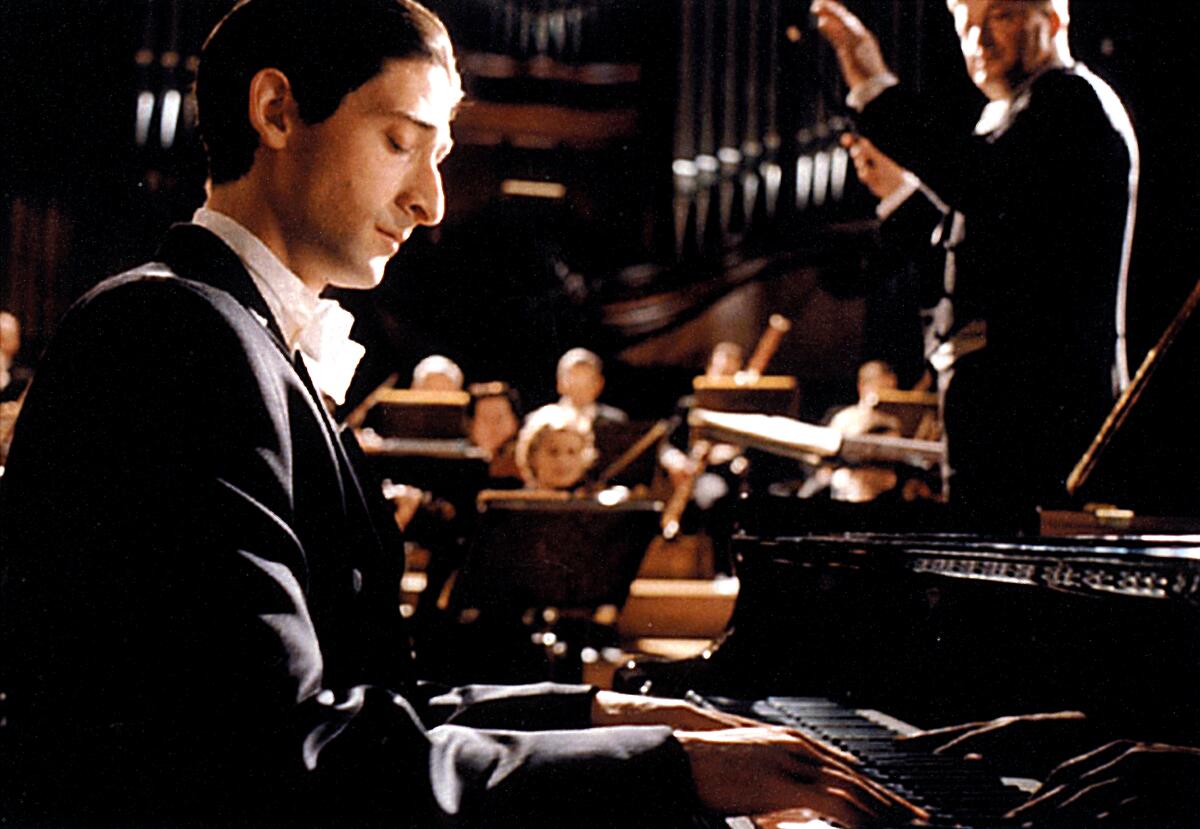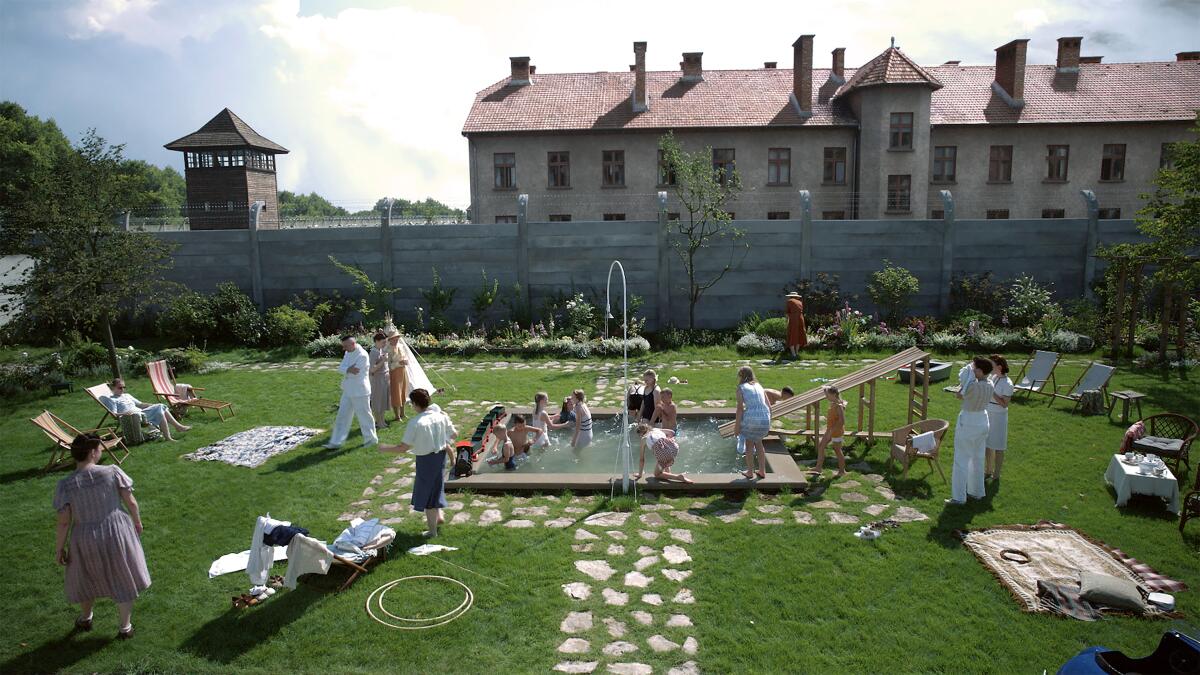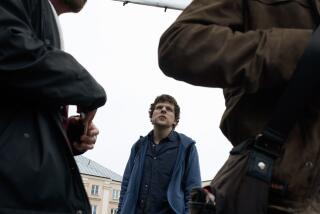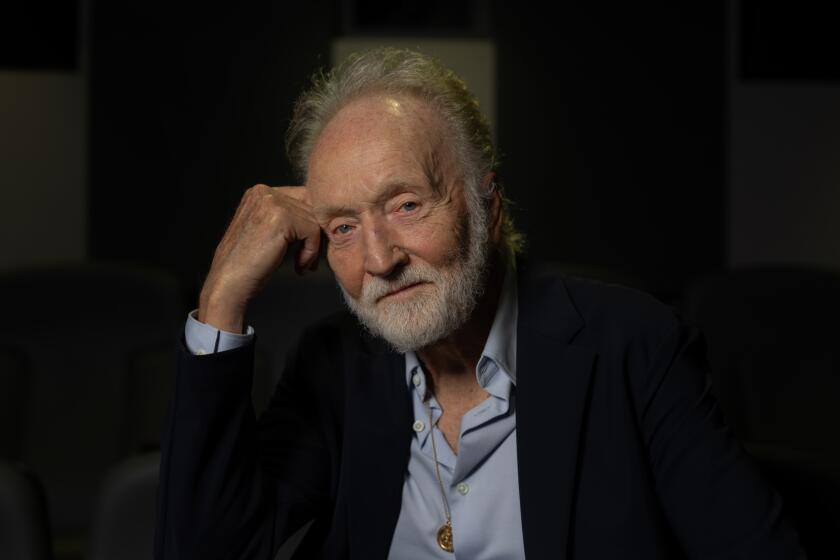‘Schindler’s List’ is 30. It may be more valuable now for how divisive it remains

On a wintry 1944 night at Auschwitz, several Jewish women, naked and shivering, are forced into a large room and plunged into total darkness. They scream and cling to each other, peering up in dread at the looming shower heads; they’ve been warned about what happens next. But it doesn’t happen. Water, real water, comes pouring out instead. The women are not going to die, at least not now. As they bathe and drink, many of them weep in relief. One can’t help but laugh, as though appreciating their deliverance for the cruel cosmic punchline it is.
It says something about the debate that “Schindler’s List” still inspires that, three decades after its release, its most terrifying sequence is often dismissed as its most fraudulent. Some version of this brush with death really did befall some of the Jewish women who worked for Oskar Schindler, the German industrialist and Nazi Party member whose rescue of more than 1,100 Jews during the Holocaust is memorialized in Steven Spielberg’s 1993 film. Bound for Schindler’s new munitions factory in Brünnlitz, in what is now the Czech Republic, the women were sent to Auschwitz for an inspection stopover that not all of them survived. Even so, the shower episode has been referenced in survivor testimony: “I remember, after they shaved my head, we were put in a dark room and cold water came down,” said Rena Finder, one of the Schindlerjuden, in a 2018 interview with Time.
But for the sharpest critics of “Schindler’s List,” the moral bankruptcy of the shower scene had little to do with its basis in fact and everything to do with Spielberg’s manipulative intent. With unconscionable virtuosity, the filmmaker still best known for the escapist thrills of “Jaws” and “Raiders of the Lost Ark” had exploited the gas chambers, the grim apotheosis of the Nazi death machine, for a moment of cheap, borderline-pornographic suspense. He had, they argued, turned Auschwitz into the staging ground for another classically Spielbergian miracle: “One could found a religion on the transformation of Zyklon B into running water,” the critic J. Hoberman wrote witheringly in his Village Voice review, an early pan amid an avalanche of critical praise.
For Hoberman and others, that scene was merely the most egregious of “Schindler’s List’s” many reversals. Here was an ostensible epic of Jewish suffering and survival, but one centered on the perspectives of two uniquely charismatic Nazis: Oskar Schindler (Liam Neeson) and Amon Goeth (Ralph Fiennes), the monstrous SS commandant whom Schindler cajoles, bribes and ultimately outwits.
“The list … is life,” we hear from Schindler’s trusted accountant, Itzhak Stern (Ben Kingsley), never mind that during the Holocaust, a list of Jewish names meant unambiguous death. To paraphrase a damning quote from Stanley Kubrick, here was a picture that honored 1,200 Jews who lived, and therefore couldn’t possibly be a truthful representation of the 6 million who died.
But how to represent the unrepresentable? Years earlier, the filmmaker Claude Lanzmann had already decided that you couldn’t, and his 1985 documentary, “Shoah,” made the most convincing possible case. Wholly refusing the nonfiction tropes of re-enactment and reconstruction (conventions by which even the toughest subject can be made digestible), Lanzmann’s film instead endlessly circled what the Holocaust survivor Emil Fackenheim called “the presence of an absence.” By focusing methodically on survivors in the present, Lanzmann hadn’t really made a film about the Holocaust; he’d made a film about the void the Holocaust left behind.
And so the extraordinary success of “Schindler’s List,” arriving some eight years after “Shoah,” was as much a violation of Lanzmann’s first principle as it was a rewriting of conventional Hollywood wisdom about what a movie could and could not show. Defying his own early doubters, Spielberg proved that you could in fact make a roundly popular movie — an audience hit, a critics’ darling, a surefire Oscar winner and a future educational tool — about the defining human catastrophe of the 20th century. You could render unspeakable atrocities in stark, harrowing but ultimately bearable and inevitably sanitized terms. You could, while purporting to tell a story drawn from true events, lead your characters through meticulous re-creations of a ghetto, a concentration camp and, yes, a gas chamber — and still bring them out of it in time to discover a measure of uplift on the other side.
Did Spielberg’s characteristic emphasis on the positive, his desire to tell a story of unlikely heroism, perseverance and courage, amount to a form of artistic denialism — a failure to confront the full, horrific magnitude of the Holocaust in cinematic terms? To ask the question is to assume that such a confrontation is even possible. And it raises still more questions that “Schindler’s List” and the many Holocaust dramas that followed it can help us answer: What do we want or expect from cinematic treatments of history? What is an artist’s appropriate response to the Holocaust (Theodor W. Adorno’s famous declaration that “to write poetry after Auschwitz is barbaric,” notwithstanding)? Must a filmmaker’s obligation to history always supersede their prerogative to entertain?
And “Schindler’s List,” it’s worth acknowledging, is inordinately, at times almost indecently entertaining. Thirty years later, it remains, even at three hours, as crackling and propulsive a narrative as any Spielberg has ever rattled off. John Williams’ keening, consoling violins can still make you weep (and make you loathe yourself a bit for weeping). Janusz Kaminski’s nimble black-and-white cinematography evokes the stark, battered realism of 1940s photographs, but it also isn’t afraid to bathe Neeson’s Schindler in a sheen of Old Hollywood glamour. Nor does the movie shy away from making an indelible screen villain out of Fiennes’ Goeth, who terrorizes his Jewish prisoners in ways both intimately personal and horrifically arbitrary.
Spielberg would later achieve a more conflicted reckoning with his own Jewish identity in “Munich,” his anguished 2005 thriller about the Israeli-Palestinian conflict. But in “Schindler’s List,” the Jews themselves seize the screen only fitfully. In a famous 1994 Village Voice symposium on “Schindler’s List,” Art Spiegelman — the author of the Holocaust-themed graphic novel “Maus” — wrote that the movie “refracts the Holocaust through the central image of a righteous gentile in a world of Jewish bit players and extras.” These bit players work, whisper, chatter, laugh, philosophize, run, hide, weep, lament and survive, sometimes as an undifferentiated human blur and sometimes with great individual vividness. (One of the movie’s most memorable survivors, Chaja Dresner, is played by Miri Fabian, a survivor herself.)
Read our original review of ‘Schindler’s List’ from 1993
Upon the movie’s release, more than a few critics argued that some of Spielberg’s Jews veered perilously close to antisemitic caricature: the ones we see hiding jewels and other valuables during a Nazi raid or the ones dealing black-market goods in the pews of a Catholic church. But then, the very act and art of dealmaking, you soon realize, is fundamental to Oskar Schindler’s story, which is, after all, the story of a German war profiteer. Spielberg is tickled by the grifter in Schindler, the wily operator who sets out to amass a fortune on the backs of Polish Jewish workers, only to then spend that same fortune to save as many of those workers as possible. He’s fascinated by the negotiations and calculations that people make under desperate circumstances, and he’s energized by the unmistakable heist-movie dimension of Schindler’s eventual plan.
Spielberg has always been a maker of comic thrillers at heart, and it’s that tension between his natural buoyancy as a filmmaker and the then-unprecedented grimness of his subject matter that can pull you into “Schindler’s List” as intently as it sometimes pushes you out. The film historian and author Annette Insdorf, one of the movie’s lone defenders in the Voice symposium, aptly noted that Schindler himself succeeded by way of “manipulation, by a showmanship (not unlike Spielberg’s) that knows — and plays — its audience, but in service of a deeper cause.” And indeed, watching “Schindler’s List,” it’s as if the mischievous genre filmmaker who delighted in bumping off Nazis in “Raiders of the Lost Ark” had now moved on to defeating them on a more prestigious, historically grounded stage.
Spielberg’s showmanship worked. “Schindler’s List” won seven Academy Awards, including best picture and director for Spielberg, who finally earned the industry recognition that had eluded him for nearly two decades. (It also won screenwriter Steven Zaillian an Oscar for his adaptation of Thomas Keneally’s 1982 book, originally titled “Schindler’s Ark.”) The film grossed $322 million worldwide, less than a third of what “Jurassic Park,” Spielberg’s other triumph of 1993, would ultimately rake in, but still far more than most had anticipated.
And while “Jurassic Park” went on to spawn an increasingly unnecessary franchise, “Schindler’s List” leaves behind a more complicated legacy. Its indirect sequels include more than a few of the Holocaust dramas that have emerged in the last three decades, nearly all of which exist within — and have sometimes self-consciously pushed back against — the very long shadow of Spielberg’s landmark.
The uplift that many embraced and others decried in the Oscar-winning “Life Is Beautiful” (1997), Roberto Benigni’s tragicomic fable about an Italian father doing everything in his imaginative power to ensure his Jewish son’s survival, could be diagnosed as either a nervier or more misguided version of the creeping sentimentality at the heart of “Schindler’s List.” Keeping its horrors largely out of the frame, Benigni’s movie has its own dubiously escapist way with a gas chamber; here, a plucky young boy’s aversion to bathing is enough to spare him the dire fate of the other children at Auschwitz.
A young girl somehow endures and survives a crowded Auschwitz gas chamber in Tim Blake Nelson’s intensely disturbing “The Grey Zone” (2001), which Spielberg himself regarded so highly that he at one point considered distributing it himself. For all that, the movie proved almost heroically unmarketable, and decidedly un-Spielbergian in its aversion to uplift. Set around the time of the famous 1944 uprising at Auschwitz, it focuses on the Sonderkommandos, the male prisoners tasked with ushering their fellow Jews into the gas chambers and disposing of their corpses afterward. Adapted from Nelson’s own play, “The Grey Zone” embraces a measure of blatant artifice with its arch dialogue and jarringly American actors (David Arquette and Steve Buscemi, among others), but visually, an unbearable brute-force realism prevails: screams, corpses, walls splashed with blood and excrement.

If Nelson’s movie never found its audience, greater recognition awaited László Nemes’ tense and enveloping “Son of Saul” (2015), which focuses, like “The Grey Zone,” on a Sonderkommando (here played by Géza Röhrig) in October 1944. But Nemes achieves a more artful and finally more persuasive vision of hell on Earth. Following his lonely protagonist in a maze of shallow-focus, background-blurring tracking shots, he sustains a terrifying level of immediacy even as he keeps the worst of the atrocities just out of sight. Here was a new kind of Holocaust movie: the death-camp drama as existential one-man odyssey.
“Son of Saul” won many awards: the Grand Prix at Cannes, the Oscar for foreign-language film and, most coveted of all, Lanzmann’s personal seal of approval. Further laying his aesthetic cards on the table, Nemes made a point in interviews of differentiating his movie from “a survivor story such as ‘Schindler’s List,’ a very good film,” he told Mubi writer Amir Ganjavie. “My film is not about survival — it is about the reality of death. Survival is a lie, it was the exception.” Not everyone bought the idea, however, that Nemes’ death-camp neorealism was ultimately any less slick or manipulative than Spielberg’s more classical suspense-thriller technique. In an admiring but ambivalent New York Times review of “Son of Saul,” the critic A.O. Scott wrote, “Mr. Nemes may disdain ‘Schindler’s List’ — as every ambitious European art-film director must — but he is very much in its debt.”
Nemes is not alone in this, and that debt, it’s worth noting, isn’t one that “Schindler’s List” asked for. The curse of outsize success is that it encourages us to see a singular achievement as something definitive, to invest it with a larger representational significance. And if there’s a reason Spielberg’s movie might actually play better now, it’s that it’s been freed from the imperative to be an all-encompassing vision of the Holocaust, that it can now be seen, more clearly, for the strange, unlikely story it has to tell. That story, about a good-hearted Nazi and a cluster of Jews who survived, is an anomaly, a heartwarming exception that proves a dreadful rule about human complicity in evil. For too long the story was treated as a narrative template, giving rise to less skilled imitators, self-conscious correctives and even the occasional Oscar-winning abomination, like Taika Waititi’s Hitler-satirizing, audience-infantilizing tearjerker “Jojo Rabbit.”
Some of the most powerful Holocaust movies since “Schindler’s List” have avoided those easy classifications. Survival stories may indeed be disproportionately represented in the annals of Holocaust cinema, but the best ones have the wit to acknowledge just how improbable, even inexplicable, the act of survival could be. I’m thinking of Lajos Koltai’s haunting, underseen “Fateless” (2005), whose disturbingly beautiful rendering of a young man’s hellish experience upends every Holocaust-movie cliché. I’m also thinking of Roman Polanski’s “The Pianist” (2002), in which the director’s own experience of fleeing the Kraków ghetto as a child gave him a uniquely personal, even darkly comical perspective on the life of the survivor Wladyslaw Szpilman. The radical deliberation of Polanski’s framing, emphasizing Szpilman’s helplessness at every turn, disgraces the usual bromides about the triumph of the human spirit, as does Adrien Brody’s still-astonishing performance.
If anything unites the two significant new Holocaust movies that have emerged this year, it’s that they both approach their subject with unusual aesthetic and ethical rigor and without much use for narratives of survival. Opening in Los Angeles theaters next month is Steve McQueen’s monumental documentary “Occupied City,” which slowly recounts the destruction of the Jews in German-occupied Amsterdam. The film’s great formal coup is to lead us on a tour of the city, explaining to us what happened on this block and in that building, but always showing us Amsterdam in the present day, never in the past. Not unlike “Shoah,” an influence buried in its every atom, “Occupied City” leaves us to imagine horrors that ultimately defeat the imagination.

A different kind of restraint is employed in Jonathan Glazer’s “The Zone of Interest” (in theaters Friday), a coolly damning, formally exacting drama about a Nazi family, led by real-life SS commandant Rudolf Höss, living next door to the gates of Auschwitz. Loosely inspired by Martin Amis’ 2014 novel, it’s a portrait of everyday evil from the inside; it brings us just close enough that we can hear the screams and the gunfire, and perhaps even smell the smoke . (It also plays, as some have pointed out, like a responsible version of 2008’s ill-advised “The Boy in the Striped Pajamas.”)
This willingness to approach atrocity from a side angle, to make points through quiet implication rather than full-blown confrontation, rests on certain expectations. It assumes a viewer’s basic familiarity with the history and iconography of the Holocaust — a familiarity that rests, in part, on depictions and re-creations we’ve seen in movies like “Schindler’s List.” And what makes “The Zone of Interest” so radical in its means is that it seeks not to perpetuate those images but rather to defamiliarize them, to cancel them out. The less we see of them, Glazer seems to argue, the more they might actually retain their power to disturb.
The ending of “The Zone of Interest,” which I won’t reveal here, dovetails with that of “Schindler’s List” in ways that are all the more fascinating for being unintended. Here, in two different movies, are two fictional depictions of real-life Nazis, both suddenly confronted with the consequences of their actions and a brief glimpse of how history will regard them. One man saved Jewish lives, and some of us may flatter ourselves into thinking we’d follow his example under similar circumstances. The other man is an efficiency expert of death, and he holds up a mirror to the human capacity for unchecked, unexamined evil. Both their stories are worth telling, pondering and remembering. Neither one can or should claim to be called definitive.
“I hope that the great numbers that are going to see [‘Schindler’s List’] will have their curiosity piqued about what was lost,” the professor and author James Young wrote in the 1994 symposium. “But I fear that they will come away sated now that they have seen the last word on the Holocaust.”
At the time, it surely did offer the last word. Thirty years later, though, it’s clear that “Schindler’s List” has begun rather than ended a conversation, and it has even invited its own sharpest rebukes. That alone may be its most meaningful and valuable legacy.
More to Read
Only good movies
Get the Indie Focus newsletter, Mark Olsen's weekly guide to the world of cinema.
You may occasionally receive promotional content from the Los Angeles Times.











